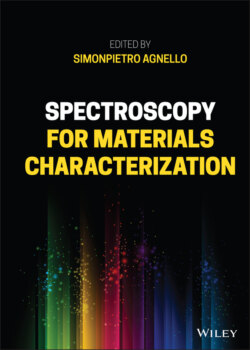Читать книгу Spectroscopy for Materials Characterization - Группа авторов - Страница 42
2.2.2 Site‐Selective Luminescence
ОглавлениеThe use of tunable lasers in the time‐resolved luminescence setup is very advantageous to improve the sensitivity in the acquisition of emission spectra. On the other hand, it allows a selective excitation of defects, on which the site‐selective luminescence is based. To provide a theoretical background on this technique, we consider the absorption and luminescence lineshapes discussed in Section 2.1.5 accounting for the homogeneous and inhomogeneous parts. In fact, each defect contributes to the absorption through a homogeneous lineshape governed by the coupling between the electronic transition and both the band vibration and the localized modes. Under the hypothesis of linear coupling with a single localized phonon ℏΩ, the homogeneous lineshape is expressed by:
(2.67)
where E 00 is the energy of the ZPL and is the Huang–Rhys factor associated with the localized mode. The inhomogeneity arises from the site‐to‐site nonequivalence of defects embedded in the amorphous network. It is well‐founded to assume that only the ZPL features a statistical distribution w inh(E 00); the total absorption lineshape, I abs(E exc), is therefore given by the convolution:
(2.68)
that makes explicit the dependence on the microscopic parameters (E 00, , ℏΩ) in Eq. (2.57). Similarly, the luminescence lineshape is the convolution between a homogeneous function, which is mirror‐symmetric of against E 00, and the inhomogeneous distribution w inh(E 00), while its amplitude is proportional to the absorbed intensity, scaled by the quantum yield factor η ≤ 1:
(2.69)
that reproduces the lineshape function appearing in Eq. (2.63).
The attempt to single out homogeneous and inhomogeneous lineshapes by site‐selective luminescence is successful only for a peculiar subclass of defects having a very low electron–phonon coupling (). In this case, Eq. (2.69) becomes:
(2.70)
Under this condition, absorption and luminescence spectra overlap and the ZPL lies in this region. It is, therefore, possible to site‐selectively excite a specific defect subset within w inh(E 00); the site‐selective luminescence intensity is given by:
(2.71)
At low temperature, L vib(E exc − E 00) as well as L vib(E 00 − E em) vanish for negative arguments, so that the site‐selective luminescence is detected with the emission resonant to excitation, E E ex = E em, namely the ZPL, and Eq. (2.71) reduces to:
(2.72)
thus allowing the measure of the inhomogeneous distribution w inh(E 00).
